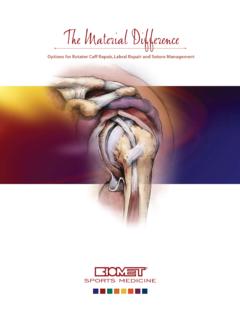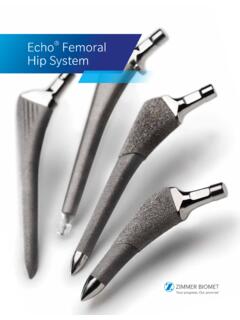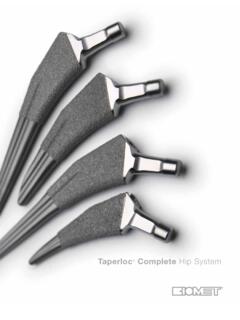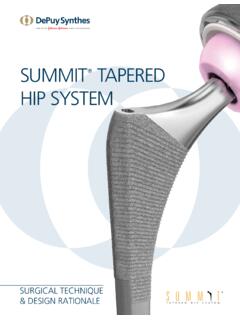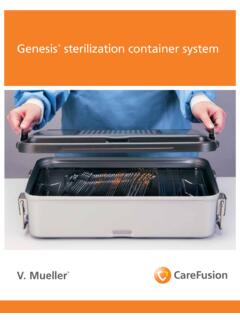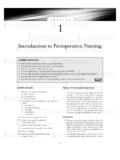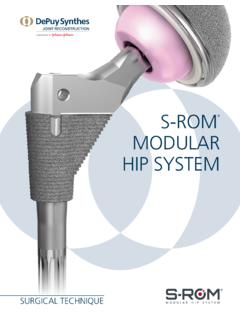Transcription of Oxford Partial Knee Microplasty Instrumentation Surgical …
1 Oxford Partial KneeMicroplasty InstrumentationSurgical Technique1 | Oxford Partial Knee Surgical TechniqueTable of ContentsOxford Partial Knee ..2 Femoral Components ..2 Tibial Components ..2 Meniscal Bearings ..2 Patient Selection ..3 The Learning Curve ..4 Preoperative X-ray Template ..5 Open vs. Minimally Invasive Technique ..6 Surgical Technique ..7 Positioning the Limb ..7 Incision ..7 Osteophyte Excision ..8 Tibial Plateau Resection ..9 The Femoral Drill Holes and Alignment ..12 Femoral Saw Cut ..14 First Milling of the Condyle ..16 Equalizing the Flexion and Extension Gaps ..17 Confirming Equality of the Flexion and Extension Gaps ..19 Preventing Impingement ..20 Final Preparation of the Tibial Plateau ..22 Final Trial Reduction ..24 Cementing the Components ..26 Appendix ..30 Postoperative Treatment ..30 Postoperative Radiographic Assessment.
2 30 Radiographic Technique ..30 Radiographic Criteria ..31 Position and Size of Components ..31 Follow-up Radiographs ..32 Ordering Information ..33 Indications and Full Prescribing Information ..522 | Oxford Partial Knee Surgical TechniqueIntroductionThe Oxford Partial Knee is the natural evolution of the original meniscal arthroplasty, which was first used in Its design continues to offer the advantage of a large area of contact throughout the entire range of movement for minimal polyethylene wear, as seen in the Oxford Partial Knee Phase I and ,3 Since 1982, the Oxford Partial Knee has been successfully used to treat anteromedial 5 If performed early in this disease process, the operation can slow the progression of arthritis in the other compartments of the joint and provide long-term symptom Oxford implant is based on its clinically successful predecessors (Phase I and Phase II)
3 Which achieved survivorship rates of 98% at 10 years,5,7 with an average wear rate of mm per ,3 Femoral ComponentsThe unique, spherically designed femoral components are made of cast cobalt chromium molybdenum alloy for strength, wear resistance and biocompatibility. The design is available in five sizes to provide an optimal fit. The sizes are parametric and have corresponding radii of articulating surface of the femoral component is spherical and polished to a very high tolerance. The appropriate size of femoral component is chosen based on the patient size, preoperative templating of lateral radiographs and intraoperative measurement confirmed with sizing spoons. Tibial ComponentsThe tibial components, also made of cast cobalt chromium molybdenum alloy, are available in seven sizes, both right and left.
4 Their shapes are designed to provide optimal bone coverage, while avoiding component overhang BearingsThe bearings are direct compression molded ultra-high molecular weight polyethylene (UHMWPE), manufactured from ArCom Direct Compression Molded Polyethylene for increased wear ,9 There are five bearing sizes to match the radii of curvature of the five femoral component sizes. For each size, there is a range of seven thicknesses, from 3 mm to 9 Partial Knee3 | Oxford Partial Knee Surgical TechniqueThere are well-defined circumstances in which the Oxford Partial Knee for medial arthroplasty is appropriate, and certain criteria must be fulfilled for success: The operation is indicated for the treatment of anteromedial Posterior bone loss on a lateral radiograph or mediolateral subluxation that does not correct on valgus stress radiographs strongly suggests damage to the anterior cruciate ligament (ACL).
5 11 If there is doubt about the integrity of the ACL, it should be assessed with a hook during the operation. The lateral compartment should be well preserved, with an intact meniscus and full thickness of articular cartilage. This is best demonstrated by the presence of a full thickness joint space visible on an A/P radiograph taken with the joint stressed into However, a grade 1 cartilage defect, marginal osteophytes and localized areas of erosion of the cartilage on the medial side of the lateral condyle are frequently seen during surgery and are not contraindications to medial compartment arthroplasty. The intra-articular varus deformity must be passively correctable to pre-disease status and not beyond. A good way to confirm this is to take valgus stressed radiographs.
6 The degree of intra-articular deformity is not as important as its ability to be passively corrected by the application of a valgus force. Varus deformity of more than 15 degrees can seldom be passively corrected to neutral; therefore, this figure represents the outer limit. Soft tissue release should never be performed. If the medial collateral ligament has shortened and passive correction of the varus is impossible, the arthritic process has progressed beyond the suitable stage for this procedure, and thus the procedure is contraindicated. Flexion deformity should be less than 15 degrees. If it is greater than 15 degrees the ACL is usually ruptured. The knee must be able to flex to at least 110 degrees under anesthetic to allow access for preparation of the femoral There must be full thickness cartilage loss on both sides of the medial compartment with bone on bone contact (Figure 1).
7 This may be demonstrated radiographically (weight bearing A/P, Rosenberg or varus stress) or arthroscopically. The results of replacement for Partial thickness cartilage loss are Both cruciate ligaments must be functionally intact. The posterior cruciate is seldom diseased in osteoarthritic knees, but the anterior cruciate is often damaged and is sometimes absent. This deficiency is a contraindication to the 1 Patient Selection4 | Oxford Partial Knee Surgical Technique The state of the patellofemoral joint (PFJ) is not a contraindication provided there is not severe damage to the lateral part of the PFJ with bone loss, grooving or subluxation. Neither the presence of preoperative anterior knee pain or cartilage loss in the PFJ have been shown to compromise the Similar arthritis in the medial part of the PFJ, however severe, or early arthritis in the lateral part of the PFJ have not compromised the outcome in reported 15 Neither the patient s age, weight nor activity level are contraindications, nor is the presence of 16 Unicompartmental arthroplasty is contraindicated in all forms of inflammatory arthritis.
8 (The pathological changes of early rheumatoid arthritis can be confused with those of medial compartment osteoarthritis). The high success rates reported5,7 were achieved in patients with anteromedial osteoarthritis, and they may not be achieved with other diagnoses. The Oxford Implant has also been used successfully in the treatment of primary avascular necrosis, which has been included as a main indication for use of the Oxford Partial The Oxford medial arthroplasty is not designed for and is contraindicated for lateral compartment replacement. The ligaments of the lateral compartment are more elastic than those of the medial, and early dislocation of the bearing has been reported. Access through a small incision is more difficult laterally than medially.
9 The Vanguard M series fixed bearing unicompartmental replacement is an available option for lateral compartment arthroplasty. The final decision whether or not to perform unicompartmental arthroplasty is made when the knee has been opened and directly Learning CurveThis Surgical technique should be used in association with the instructional video of the operation. As with other Surgical procedures, errors of technique are more likely when the method is being learned. To reduce these to a minimum, surgeons are required by the FDA in the United States, and strongly recommended throughout the world, to attend an Advanced Instructional Course on the Oxford Partial Knee before attempting the operation. Masters Courses are also offered to enhance skills through round-table discussions, technical tips, Surgical issues, case studies and | Oxford Partial Knee Surgical TechniqueFigure 3A medium size femoral component is appropriate for most patients.
10 In fact, it was the only size used in the Phase I and II , the small size is typically utilized for small women (typically less than 5 ft 5 in, 165 cm tall) and the large size in large men (typically more than 5 ft 7 in, 170 cm tall).19 The extra large is only needed in very large men and the extra small in very small women. If there is doubt between small/medium or medium/large, it is usually best to use the medium. The extra small should only be used in very small X-ray TemplateThe size of femoral component can be chosen preoperatively using X-ray templates (Figure 2). A true lateral radiograph is required to accurately template. Apply the outlines on the template to the X-ray image of the medial femoral condyle. The line along the central peg of the implant should be 10 degrees flexed compared to the long axis of the femoral shaft.



